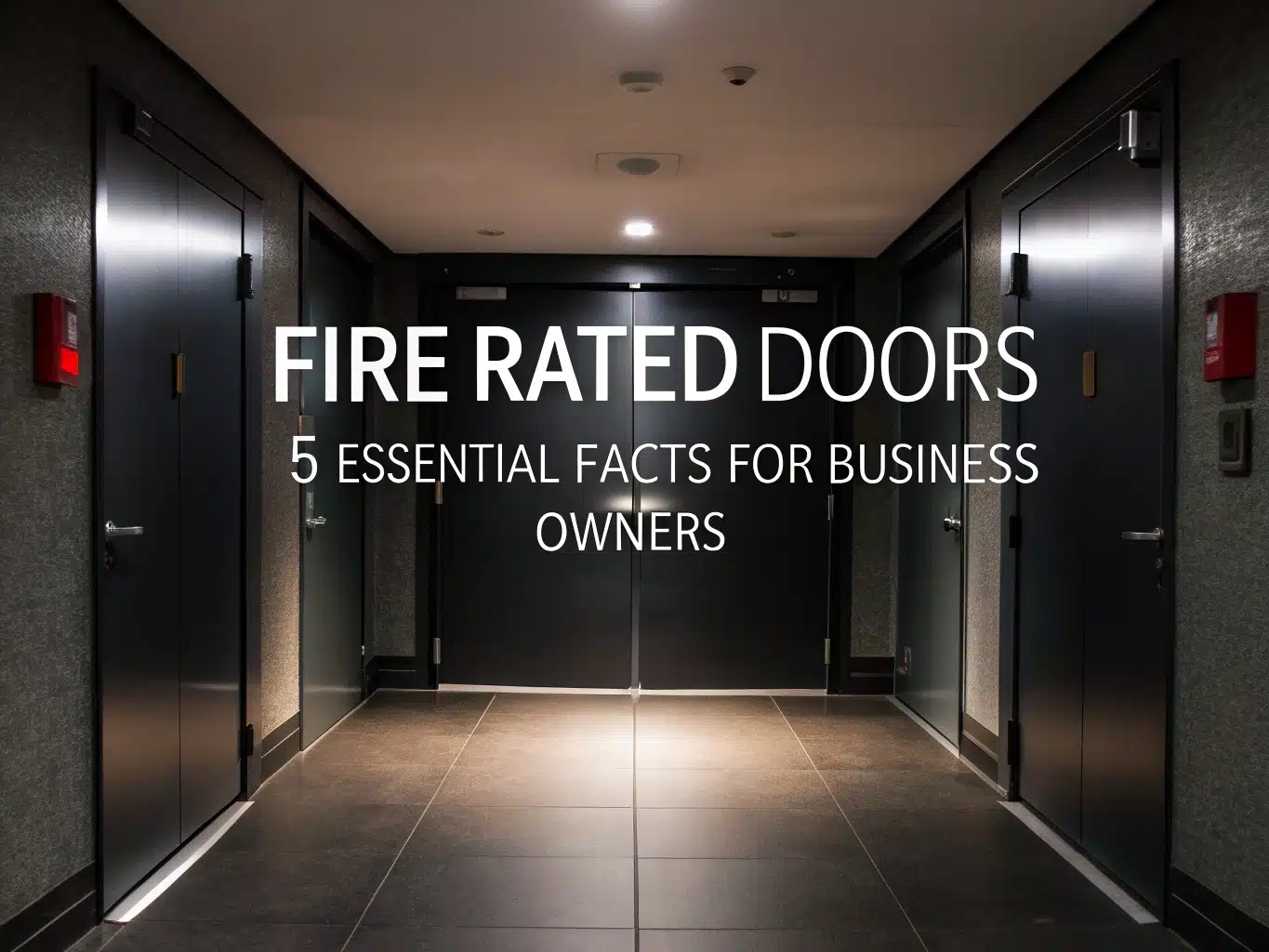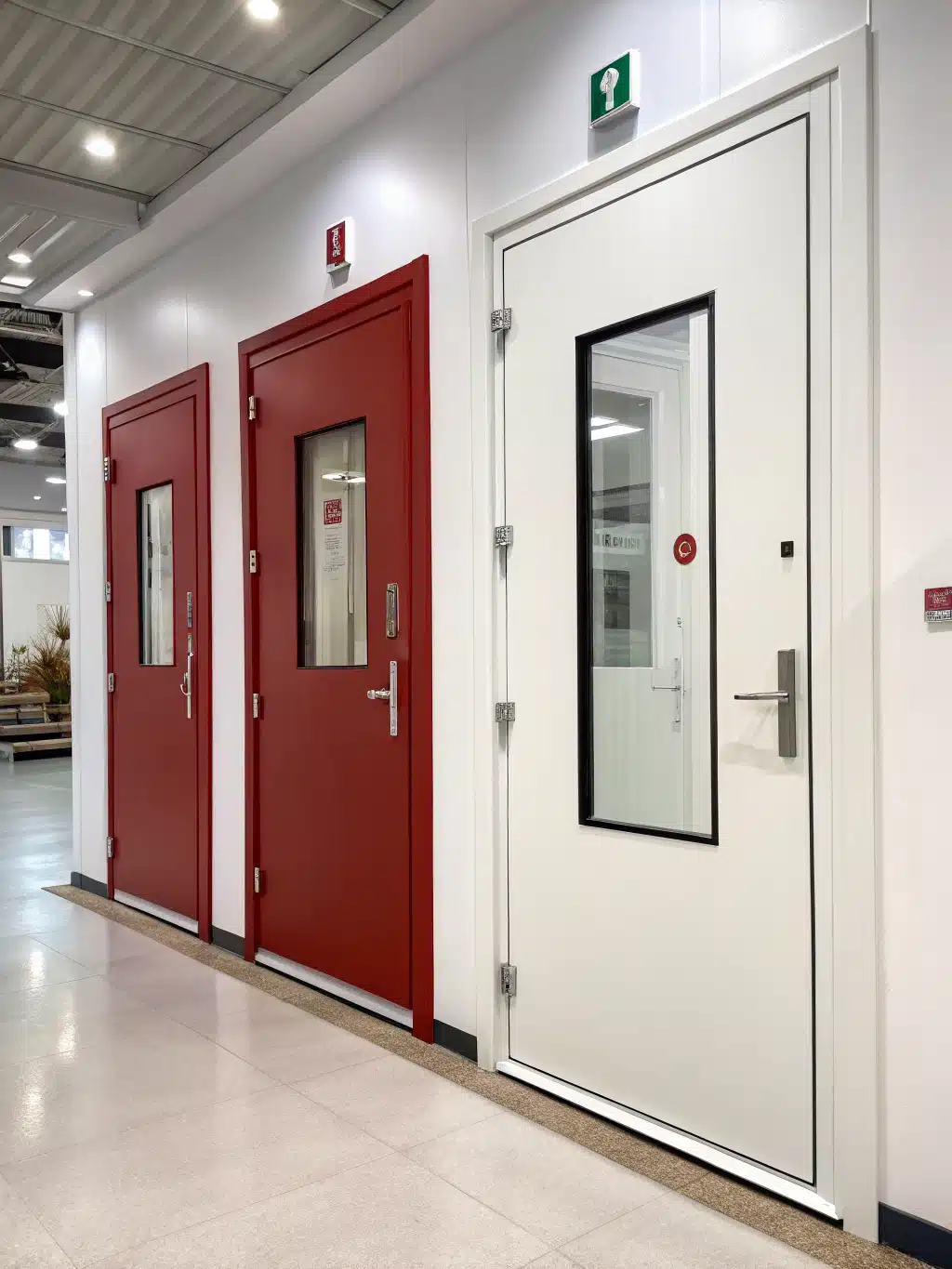
Ever wondered how critical fire rated doors are for your business? These doors are more than just entries; they’re silent guardians. Ensuring safety and meeting building codes depends heavily on these barriers. Let’s unravel why every business owner should pay attention to these lifesavers.
Fire rated doors serve as critical life-saving barriers in commercial buildings, designed to contain flames and smoke for specific time periods while allowing safe evacuation during emergencies. Recent data shows that properly maintained fire doors can reduce property damage by up to 58% and significantly decrease injury risks during building fires.
Introduction to Fire Rated Doors
Fire rated doors are specialized building components engineered to resist flames, smoke, and toxic gases for designated time periods. These doors form a crucial part of a building’s passive fire protection system, creating compartments that slow fire spread and protect evacuation routes. For business owners, these doors aren’t just about meeting building codes—they’re about protecting lives, assets, and ensuring business continuity during emergencies.
Commercial buildings face strict regulations regarding fire door installation, maintenance, and inspection. Understanding these requirements helps prevent costly violations while creating safer environments for employees and customers. The investment in quality fire doors pays dividends through enhanced safety, potential insurance benefits, and peace of mind.

Understanding Fire Ratings
Fire door ratings indicate how long a door can withstand standard fire conditions before failing. These ratings are determined through rigorous testing procedures where doors are exposed to extreme temperatures exceeding 1,700°F. The most common ratings include:
- 20-minute rating: Entry-level protection, often used for smoke barriers and residential applications
- 45-minute rating: Common for corridor and room separations
- 60-minute rating: Used for stairwells and areas requiring moderate protection
- 90-minute rating: Applied in high-risk areas and vertical shafts
- 180-minute rating: Maximum protection for critical boundaries and extreme hazard areas
Selecting the appropriate rating depends on several factors including the wall’s fire resistance rating, building occupancy type, and specific location within the structure. According to Overhead Door of Puget Sound, the fire door rating must be at least 75% of the surrounding wall’s rating in most commercial applications. This ensures proper compartmentalization during fire events.
Certification and Compliance Essentials
Key Standards and Regulations
Fire doors must comply with several critical regulatory standards that govern their construction, installation, and maintenance. The primary standards include:
- NFPA 80: Standard for Fire Doors and Other Opening Protectives
- NFPA 101: Life Safety Code
- IBC: International Building Code
- IFC: International Fire Code
These standards establish minimum requirements for fire door assemblies and are regularly updated to reflect new safety research and technologies. Local jurisdictions may adopt these codes with modifications, so checking with local authorities is essential.
Core Compliance Requirements
All fire rated doors must meet specific functional requirements to maintain their certification. The three most fundamental compliance elements include:
- Self-closing mechanism: Doors must automatically close and latch after opening
- Positive latching: Doors must securely latch when closed to prevent them from being pushed open by fire pressure
- Visible labeling: Permanent labels must display the manufacturer, fire rating, and certification agency
According to Vortex Doors, tampering with these components or modifying fire doors in any way can void their certification and create serious safety hazards. This includes drilling unauthorized holes, replacing hardware with non-rated components, or propping doors open.
Inspection and Maintenance Protocols for 2025
Updated regulations for 2025 have strengthened inspection requirements for commercial fire doors. Business owners must now ensure regular inspections are conducted and properly documented. These inspections help identify potential issues before they compromise safety.
Regular Inspection Checklist
| Inspection Point | Requirement | Frequency |
|---|---|---|
| Labels and certification | Must be visible and legible | Quarterly |
| Door operation | Smooth opening/closing without binding | Monthly |
| Self-closing mechanism | Door closes completely from any open position | Monthly |
| Latching hardware | Securely engages when door closes | Monthly |
| Gaps and clearances | Maximum 3/8″ at bottom, 1/8″ at sides and top | Quarterly |
| Intumescent seals | Intact, undamaged, and properly attached | Quarterly |
| Glazing (if present) | No cracks or damage | Quarterly |
| Hinges and bearings | Secure, lubricated, and functioning | Semi-annually |
Maintenance Tips for Longevity
Proper maintenance extends the life of fire doors while ensuring they’ll function correctly during emergencies. Key maintenance practices include:
- Lubricating hinges and hardware with silicone-based products (avoid petroleum-based lubricants)
- Adjusting closing speed to ensure doors close completely but not forcefully
- Cleaning tracks and thresholds to remove debris that might prevent proper closure
- Immediately repairing or replacing damaged components with certified parts
- Keeping detailed maintenance logs for compliance and insurance purposes
Types of Fire Rated Doors and Suitable Placements
Different building areas require specific types of fire doors based on their function and fire risk. Understanding proper placement helps optimize safety and compliance.
Application of Various Ratings
“The fire rating required for a door is directly tied to its location within the building and the type of separation it provides. Higher-risk areas demand higher ratings to provide adequate protection time for evacuation and emergency response.” – Fire Safety Engineer
Common applications for different fire ratings include:
- 20-minute doors: Smoke barriers, residential applications, and interior room separations
- 45-minute doors: Corridors, room separations in commercial buildings
- 60-minute doors: Stairwells, mechanical rooms, and areas with moderate hazards
- 90-minute doors: Elevator lobbies, exit enclosures, and areas connecting to high-hazard spaces
- 180-minute doors: Extreme hazard boundaries, critical infrastructure protection
Strategic Installation Points
According to Industrial Door Company, fire doors are typically required in these key locations:
- Stairwell enclosures and exit passageways
- Corridor separations and horizontal exits
- Walls separating mixed occupancies or tenants
- Enclosures for elevator shafts and vertical openings
- Rooms containing hazardous materials or equipment
- Areas with high-value assets requiring protection
- Boundaries between different fire zones within a building
Construction, Seals, and Hardware
The effectiveness of fire doors depends on their construction materials and components. Each element plays a critical role in the door’s ability to resist fire and smoke.
Essential Materials and Features
Fire rated doors are constructed with specialized materials designed to withstand high temperatures:
- Core materials: Mineral cores, solid timber cores, or steel cores depending on rating
- Frames: Typically steel or specially treated wood with fire-resistant properties
- Edge seals: Intumescent strips that expand when heated to seal gaps
- Smoke seals: Flexible gaskets that prevent smoke passage
- Hardware: Fire-rated hinges, closers, locks, and latches
Importance of Certified Components
All components of a fire door assembly must be tested and certified together as a complete system. This includes:
- Glazing: If windows are present in fire doors, they must use special fire-rated glass that can withstand the same temperatures as the door itself
- Intumescent strips: These expand up to 7 times their original size when heated, sealing gaps around the door
- Hardware: All hardware must be labeled and certified for use with fire doors
- Closers: Must provide sufficient force to overcome air pressure differences during fires
Mixing components from different manufacturers or using non-certified parts can compromise the entire system’s integrity. Always verify compatibility when replacing any part of a fire door assembly.
Recommended Fire Rated Door Products
Here are some quality fire rated door options that meet various commercial needs:

20-Minute Fire Rated MDF Door
- Fire-rated to provide safety for 20 minutes
- Elegant 2-panel archtop design
- Right-hand in-swing configuration
- Primed for easy painting
- Perfect for home or office use

Double Fire Exit Door with Panic Bar
- Includes panic bar for quick exit
- Double door design for wide access
- Left side-active leaf configuration
- Sturdy gray finish
- Ideal for commercial or industrial spaces

Single Fire Exit Door with Panic Bar
- Designed for quick, easy exits
- Sturdy gray finish for visibility
- Right side-hinged for effortless opening
- Comes with trusted panic bar mechanism
- Ideal for emergency exits
Conclusion and Summary of Key Considerations
Fire rated doors represent a critical safety investment for any commercial property. They protect lives, limit property damage, and help businesses maintain compliance with building codes. The five essential facts business owners should remember include:
- Fire ratings indicate time resistance—choose doors with appropriate ratings for specific locations
- Regular inspection and maintenance are legally required and vital for safety
- All components must be certified and tested as a complete assembly
- Self-closing, positive latching, and proper labeling are non-negotiable requirements
- Strategic placement at key building points maximizes protection and evacuation safety
By prioritizing proper selection, installation, and maintenance of fire rated doors, business owners not only meet legal obligations but also demonstrate a commitment to occupant safety. This attention to fire protection details can make the critical difference during an emergency, potentially saving lives and minimizing business disruption.
FAQs
What Is A Fire Rated Door?
A fire-rated door is a type of door that is designed to withstand the spread of fire for a specific period, providing occupants with added time to evacuate and helping to contain the fire to one area.
How Long Do Fire Rated Doors Last?
The durability of a fire-rated door primarily depends on its usage and maintenance but generally lasts between 20 to 30 years, assuming regular inspections and proper maintenance are conducted.
Are Fire Rated Doors Required In Residential Buildings?
In many areas, building codes require fire-rated doors in certain residential applications, like entrances to garages or basements, to enhance safety by preventing fire spread.
How Do You Know If A Door Is Fire Rated?
You can typically identify a fire-rated door by checking for a certification label or a metal plate that states its fire rating, usually found on the side or top of the door panel.
Can Fire Rated Doors Be Used As Exterior Doors?
Yes, fire-rated doors can be used as exterior doors, offering both fire resistance and security for the building. However, they must be weather resistant and properly installed to function effectively.

Abdelbarie Elkhaddar
Glamorwood Ltd.
A door expert and home improvement writer with over 12 years of experience. I help homeowners and contractors choose smart, stylish, and secure doors.






Leave a Reply